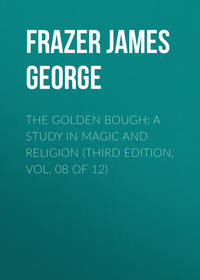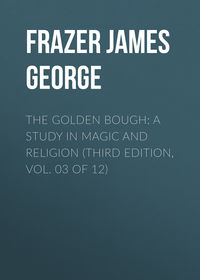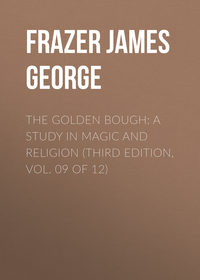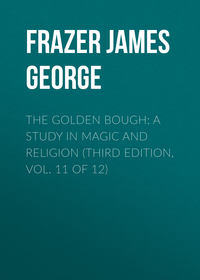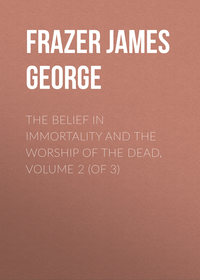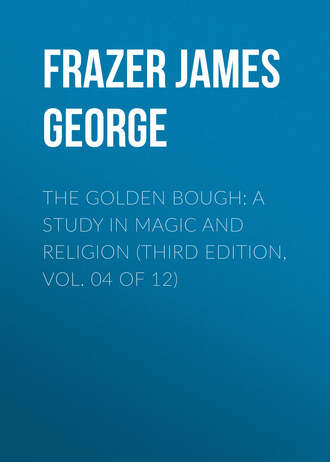 полная версия
полная версияThe Golden Bough: A Study in Magic and Religion (Third Edition, Vol. 04 of 12)
734
E. Petitot, Monographie des Dènè-Dindjiè (Paris, 1876), p. 38. The same ceremony is performed, oddly enough, to procure the death of an enemy.
735
Hamilton's “Account of the East Indies,” in Pinkerton's Voyages and Travels, viii. 360 sq. In general we are merely told that these Indian devotees swing on hooks in fulfilment of a vow or to obtain some favour of a deity. See Duarte Barbosa, Description of the Coasts of East Africa and Malabar in the beginning of the Sixteenth Century, translated by the Hon. H. E. J. Stanley (Hakluyt Society, London, 1866), pp. 95 sq.; Gaspar Balbi's “Voyage to Pegu,” in Pinkerton's Voyages and Travels, ix. 398; Sonnerat, Voyage aux Indes orientales et à la Chine, i. 244; S. Mateer, The Land of Charity, p. 220; W. W. Hunter, Annals of Rural Bengal,5 p. 463; North Indian Notes and Queries, i. p. 76, § 511.
736
V. Ball, Jungle Life in India (London, 1880), p. 232.
737
W. W. Hunter, Annals of Rural Bengal5 (London, 1872), p. 463.
738
G. W. Leitner, The Languages and Races of Dardistan (Lahore, 1878), p. 12.
739
Sarat Chandra Mitra, “Notes on two Behari Pastimes,” Journal of the Anthropological Society of Bombay, iii. 95 sq.
740
H. H. Wilson, “The Religious Festivals of the Hindus,” Journal of the Royal Asiatic Society, ix. (1848) p. 98. Compare E. T. Dalton, Descriptive Ethnology of Bengal, p. 314; Monier Williams, Religious Life and Thought in India, p. 137; W. Crooke, “The Legends of Krishna,” Folk-lore, xi. (1900) pp. 21 sqq.
741
The Hymns of the Rigveda, vii. 87. 5 (vol. iii. p. 108 of R. T. H. Griffith's translation, Benares, 1891); H. Oldenberg, Die Religion des Veda, pp. 444 sq.
742
J. G. Kohl, Die deutsch-russischen Ostseeprovinzen (Dresden and Leipsic, 1841), ii. 268 sqq.
743
L. v. Schroeder, “Lihgo (Refrain der lettischen Sonnwendlieder),” Mitteilungen der Anthropologischen Gesellschaft in Wien, xxxii. (1902) pp. 1-11.
744
S. W. Tromp, “Uit de Salasila van Koetei,” Bijdragen tot de Taal- Land- en Volkenkunde van Nederlandsch-Indië, xxxvii. (1888) pp. 87-89.
745
J. Perham, “Manangism in Borneo,” Journal of the Straits Branch of the Royal Asiatic Society, No. 19 (Singapore, 1887), pp. 97 sq.; E. H. Gomes, Seventeen Years among the Sea Dyaks of Borneo (London, 1911), pp. 169, 170, 171; H. Ling Roth, The Natives of Sarawak and British North Borneo, i. 279.
746
C. Bock, The Head-hunters of Borneo (London, 1881), pp. 110-112.
747
Hyginus, Astronomica, ii. 4, pp. 34 sqq., ed. Bunte; id., Fabulae, 130; Servius and Probus on Virgil, Georg. ii. 389; Festus, s. v. “Oscillantes,” p. 194, ed. C. O. Müller; Athenaeus, xiv. 10, p. 618 e f; Pollux, iv. 55; Hesychius, s. vv. Ἀλῆτις and Αἰώρα; Etymologicum magnum, s. v. Αἰώρα, p. 42. 3; Schol. on Homer, Iliad, xxii. 29. The story of the murder of Icarius is told by a scholiast on Lucian (Dial. meretr. vii. 4) to explain the origin of a different festival (Rheinisches Museum, N.F., xxv. (1870) pp. 557 sqq.; Scholia in Lucianum, ed. H. Rabe, p. 280). As to the swinging festival at Athens see O. Jahn, Archäologische Beiträge, pp. 324 sq.; Daremberg et Saglio, Dictionnaire des antiquités grecques et romaines, s. v. “Aiora”; Miss J. E. Harrison, in Mythology and Monuments of Ancient Athens, by Mrs. Verrall and Miss J. E. Harrison, pp. xxxix. sqq.
748
Servius on Virgil, Aen. xii. 603: “Et Varro ait: Suspendiosis quibus iusta fieri ius non sit, suspensis oscillis veluti per imitationem mortis parentari.”
749
Servius on Virgil, Georg. ii. 389; id., on Aen. vi. 741.
750
Spencer and Gillen, Native Tribes of Central Australia, pp. 505 sq.
751
Festus, s. v. “Oscillantes,” p. 194, ed. C. O. Müller. This festival and its origin are also alluded to in a passage of one of the manuscripts of Servius (on Virgil, Georg. ii. 389), which is printed by Lion in his edition of Servius (vol. ii. 254, note), but not by Thilo and Hagen in their large critical edition of the old Virgilian commentator. “In Schol. Bob. p. 256 we are told that there was a reminiscence of the fact that, the bodies of Latinus and Aeneas being undiscoverable, their animae were sought in the air” (G. E. M. Marindin, s. v. “Oscilla,” W. Smith's Dictionary of Greek and Roman Antiquities,3 ii. 304).
752
Hyginus, Fab. 130.
753
Probus on Virgil, Georg. ii. 385.
754
Virgil, Georg. ii. 388 sqq.
755
See above, p. 157.
756
W. G. Clark, Peloponnesus (London, 1858), p. 274.
757
J. T. Bent, The Cyclades (London, 1885), p. 5.
758
J. T. Bent, quoted by Miss J. E. Harrison, Mythology and Monuments of Ancient Athens, p. xliii.
759
Vincenzo Dorsa, La Tradizione greco-latina negli usi e nelle credenze popolari della Calabria Citeriore (Cosenza, 1884), p. 36. In one village the custom is observed on Ascension Day instead of at Christmas.
760
Valdés, Los Majos de Cadiz, extract sent to me in the original Spanish by Mr. W. Moss, of 21 Abbey Grove, Bolton, March 23rd, 1907.
761
E. Doutté, Magie et religion dans l'Afrique du nord (Algiers, 1908), pp. 580 sq.
762
W. W. Rockhill, “Notes on some of the Laws, Customs, and Superstitions of Korea,” American Anthropologist, iv. (1891) pp. 185 sq.
763
Pausanias, v. 1. 4.
764
Pausanias, vi. 20. 9.
765
Taboo and the Perils of the Soul, pp. 88 sq.
766
J. L. van Hasselt, “Aanteekeningen aangaande de gewoonten der Papoeas in de Dorebaai, ten opzichte van zwangerschap en geboorte,” Tijdschrift voor Indische Taal- Land- en Volkenkunde, xliii. (1901) p. 566.
767
J. H. Letteboer, “Eenige aanteekeningen omtrent de gebruiken bij zwangerschap en geboorte onder de Savuneezen,” Mededeelingen van wege het Nederlandsche Zendelinggenootschap, xlvi. (1902) p. 45.


